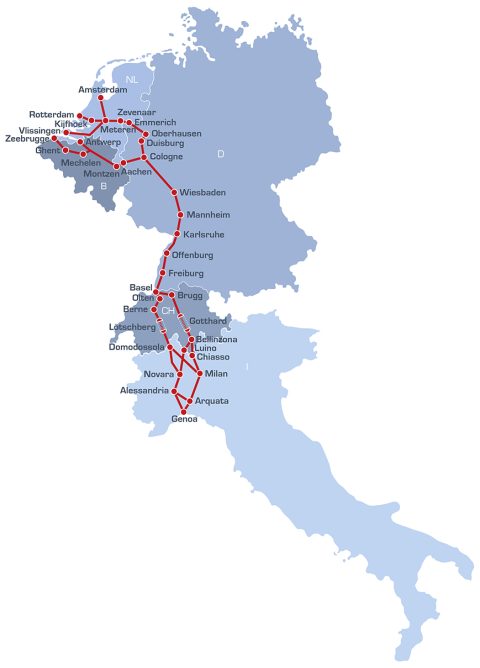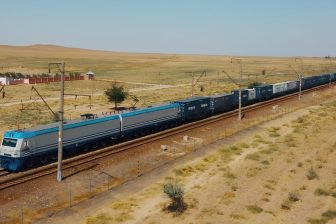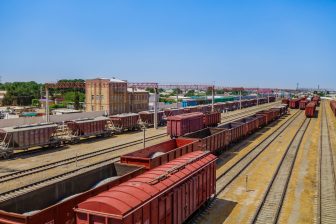
Rhine-Alpine Corridor: what to expect with the coming upgrades
The Rhine-Alpine Corridor is one of the backbones of the European Union when it comes to transportation services. This is especially true for rail freight since the corridor connects two of the largest European ports, Genoa and Rotterdam, as well as many other hubs along the way. However, the corridor still needs significant upgrades, with various projects still needing to be commissioned and, therefore, more disruptions to come.
The Rhine-Alpine Corridor runs through Italy, Switzerland, Germany, Belgium, and the Netherlands. The most significant obstacles can be linked to different approaches that these countries take when it comes to rail projects. For example, ETCS deployment along the corridor is significantly unbalanced. Another hurdle is finding alternative routes to divert traffic during construction and maintenance works.
Apparent lack of alternatives
Despite a significant amount of projects still needing to be carried out and requiring significant amounts of time and resources, alternatives do not seem to abound. The annual report published by the Rhine-Alpine Corridor listed all the current and future projects along the corridor. However, it is not clear what the strategy is for alternative routes for most of the projects. For example, the report provided information about alternative routes only for the upgrade of the Ranstatt main line. While the section will be closed in 2024, trains will be re-routed via France thanks to a collaboration between the German and French infrastructure managers, DB Netz and SNCF Réseau.

ETCS implementation along the Rhine-Alpine Corridor
The deployment of ETCS along the Rhine-Alpine Corridor, and in the EU in general, is occurring at very different speeds in different countries. Belgium is surely at the forefront when it comes to this, with the country counting on having the whole rail network equipped with ETCS by the end of 2025. When it comes to the Rhine-Alpine corridor in Belgium, 74 kilometres were equipped with ETCS in 2022, including the Liège-Visé line, in the east, and the Driehoekstraat-Walenhoek section in Antwerp, in the north.
Throughout 2022, Germany has been making some steps towards ETCS implementation on the lines that are part of the Rhine-Alpine Corridor. ETCS Level 2 was installed on the Darmstadt Süd-Hemsbach section. Moreover, the ETCS L2 was tested along the Haltingen-Freiburg line and new electronic interlockings are currently being installed between Bühl and Baden-Baden. In the remaining months of 2023, the software for ETCS L1 deployment between Weil am Rhein and Basel will be upgraded. For the border-crossing section between Cologne and Venlo (NL), the Rhine-Alpine corridor says it will be completed in 2028.
In Switzerland, most of the railway network already has ETCS, since the country was among the first to start implementing it. Moreover, the Italian section of the corridor between Genoa and Tortona will soon be equipped with ETCS L2. On the other hand, the Netherlands seems to be lagging behind, going at a much slower pace. This is because the Dutch claim that their Automatic Train Protection system still works fine, this there is no urgent need to implement ETCS.
Netherlands: Rotterdam is the centre of the project
The projects concerning the Rhine-Alpine Corridor in the Netherlands revolve around Rotterdam. Fire estinguishing facilities need to be upgraded at various railway yards, including Maasvlakte West, Botlek, Europoort, Pernis, and Waalhaven South. Moreover, six tracks to accommodate 740-metre trains will be ready at the Maasvlakte West yard by 2026. Finally, the Dutch government is working on implementing new sensors that would allow more flexibility when it comes to slot allocation. The sensors were installed, as a test, at Rotterdam Botlek in 2022 and 1,4 million euros were allocated to have them in more Dutch rail yards.

Belgium: longer trains are the goal
Many of the projects in Belgium concern connectivity to and from the port of Zeebrugge. Eight new tracks were installed at the port’s marshalling yard, including two able to accommodate longer trains. Three more tracks will be extended at the siding facility of Pelikaan, with the first phase to be completed in 2023-24. In addition, there is aproject to add a third track between Brugge and Dudzele, which was slowed down by the COVID-19 pandemic. A third and fourth tracks will also be built between Brugge and Ghent, which should be commissioned in 2024.
Another focal point for Belgium is the possibility of running 740-metre trains along the Rhine-Alpine Corridor. For this purpose, four tracks are currently being built at the Montzen bundle, which should be ready to use in September. The Ghent-Zeehaven rail yard was also upgraded in this regard, with two tracks being extended, increasing the total to three. Finally, a study called “Side tracks 740m” was presented to Infrabel to identify where these kinds of investments are more needed. Scope of financing will be defined this year.
Germany: finish line still seems far
There are a handful of main projects in Germany for the Rhine-Alpine Corridor, including the upgrades of the Emmerich-Oberhausen, Karlsruhe-Basel, Frankfurt-Mannheim, and Cologne-Dortmund lines. For the Emmerich-Oberhausen line, catenary and engineering upgrades are currently taking place in Rees, Voerde, and Dinslaken. Additionally, this year should also see the start of the works on the Oberhausen-Sterkrade line and for the third track between Dinslaken and Voerde.
For the line connecting Karlsrhue to Basel, the connections between the tubes in the Ranstatt Tunnel were completed. However, many other projects on this line are still at a embryo stage, with documents being submitted but not much work being carried out. It is not clear yet what the timetable for all these projects is, since some still require discussions in the German parliament. When it comes to Basel, six new tracks were built to be used as shunting tracks to revive traffic along the Rheintalbahn.
For the Frankfurt-Mannheim line, the design of the prjoect has been chosen and will link the Cologne-Frankfurt and Mannheim-Stuttgart high-speed railways. However, similarly to the Karlsrhue-Basel line, the project is in its very early stages, with parliamentary referrals still to take place. For the Cologne-Dortmund line, the section between Düsseldorf and Reisholz have been increased from four to six to boost traffic on the Rhein-Ruhr Express.
Switzerland: it’s all about the tunnels
For the Helvetic Federation, the main projects for the Rhine-Alpine corridor focus on improving the shunting yard in Basel as well as the Ceneri and Lötschberg Base tunnels. In Basel, new parking areas for locomotives will be built and the existing sidings will be extended up to 750 metres. These improvements in Basel should be delivered in 2025. For the Ceneri Tunnel, the plan is to adjust the infrastructure to transport non-cranable semi-trailers. This should start happening by the end of this year.
Concerning the Lötschberg Base Tunnel, the Swiss government needs to decide whether to carry out a partial or a total extension. The partial extension would entail the installation of a second tube between Ferden and Mitholz. However, since this plan would cause the closure of the infrastructure for eight months, the government might decide to go for a bigger project. Construction is expected to start in 2026 and, according to what the decision will be, they will finish in 2033 or 2034.

Italy: improving Genoa-Milan connectivity
When it comes to Italy, the main project for the Rhine-Alpine Corridor is the upgrade of the line between Milan and Genoa. The protagonist of this plan is the Third Valic, which will link the port to the corridor with a brand new infrastructure. However, there is a focus to also accommodate longer trains and put non-cranable semi-trailers on the rail.
The Pavia-Voghera line is currently being renewed to enable it to run 740-metre trains, which should start happening by 2026. Moreover, the section stretching between Domodossola, Sesto Calende, and Arona is being upgraded to transport non-cranable semi-trailers. This project is being co-funded by the Swiss government and should be concluded in 2028.



